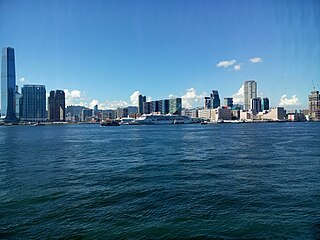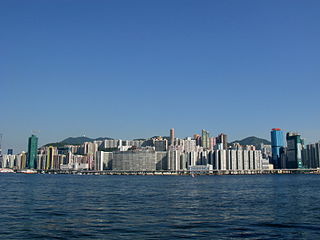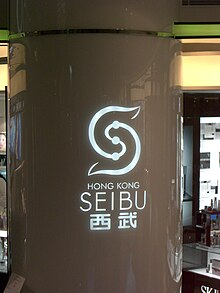
Demographic features of the population of Hong Kong include population density, ethnicity, education level, the health of the populace, religious affiliations, and other aspects.

Hong Kong Island is an island in the southern part of Hong Kong. The island, known originally and on road signs simply as "Hong Kong", had a population of 1,289,500 and a population density of 16,390 per square kilometre (42,400/sq mi), as of 2008. The island had a population of about 3,000 inhabitants scattered in a dozen fishing villages when it was occupied by the United Kingdom in the First Opium War (1839–1842). In 1842, the island was formally ceded in perpetuity to the UK under the Treaty of Nanking and the City of Victoria was then established on the island by the British Force in honour of Queen Victoria. The Central area on the island is the historical, political and economic centre of Hong Kong. The northern coast of the island forms the southern shore of the Victoria Harbour, which is largely responsible for the development of Hong Kong due to its deep waters favoured by large trade ships.

Kowloon is an urban area in Hong Kong comprising the Kowloon Peninsula and New Kowloon. It has a population of 2,019,533 and a population density of 43,033/km2 (111,450/sq mi) in 2006. It is one of the three regions of Hong Kong, along with Hong Kong Island and the New Territories, and is the smallest and most densely populated.
The culture of Hong Kong is primarily a mix of Chinese and Western influences, stemming from Lingnan Cantonese roots and later fusing with British culture due to British colonialism. As an international financial center dubbed "Asia's World City", contemporary Hong Kong has also absorbed many international influences from around the world. Moreover, Hong Kong also has indigenous people and ethnic minorities from South and Southeast Asia, whose cultures all play integral parts in modern-day Hong Kong culture. As a result, after the 1997 transfer of sovereignty to the People's Republic of China, Hong Kong has continued to develop a unique identity under the rubric of One Country, Two Systems.

Ma Tau Wai is an area in the Kowloon City District, Kowloon, Hong Kong. It was originally a walled village between present-day Argyle Street and Prince Edward Road West, east of present-day St. Teresa's Hospital.

Sha Tin, also spelt Shatin, is a neighbourhood along Shing Mun River in the eastern New Territories, Hong Kong. Administratively, it is part of the Sha Tin District. Sha Tin is one of the neighbourhoods of the Sha Tin New Town project.

Diamond Hill (Chinese: 鑽石山; pinyin: Zuànshí shān is a hill in the east of Kowloon, Hong Kong. The name also refers to the area on or adjacent to the hill. It is surrounded by Ngau Chi Wan, San Po Kong, Wong Tai Sin and Tsz Wan Shan. Its northeast is limited by the ridge. It is principally a residential district. Administratively, the area is part of Wong Tai Sin District.

During the British colonial era, English was the sole official language until 1978. Today, the Basic Law of Hong Kong states that English and Chinese are the two official languages of Hong Kong. All roads and government signs are bilingual, and both languages are used in academia, business and the courts, as well as in most government materials today.

Ma Tau Kok is a place north of To Kwa Wan, south-east of modern-day Ma Tau Chung and south-west of the former Kai Tak Airport in Hong Kong. It was a cape in Kowloon Bay in Victoria Harbour and opposite to the Sacred Hill and the mouth of Ma Tau Chung. Ma Tau Kok is a mixed industrial and residential area.

Thais in Hong Kong form one of the smaller populations of ethnic minorities in Hong Kong, and a minor portion of the worldwide Thai diaspora.

Shanghainese people in Hong Kong have played an important role in the region, despite being a relatively small portion of the Han Chinese population. "Shanghainese" is a term that refers to both the Wu Chinese language and the Han Chinese subgroups from the city of Shanghai and the peoples of the Jiangnan region in Hong Kong more broadly, particularly those with ancestral homes in parts of southern Jiangsu (Kiangsu), northern Zhejiang (Chekiang) and Anhui provinces.

According to the 2016 census, Islam is practised by 4.1% of the population of Hong Kong, or about 300,000 Muslims. Of this number, 50,000 are Chinese, 150,000 are Indonesians and 30,000 are Pakistanis, with the rest from other parts of the world. The vast majority of Muslims in Hong Kong are Sunni.
Koreans in Hong Kong formed a population of 13,288 individuals as of 2011, a mid-range size compared to Korean diaspora populations in other cities in China and Southeast Asia.
Articles related to Hong Kong include:
Hongkongers, Hong Kongers, Hong Kongese, Hongkongese, Hong Kong citizens and Hong Kong people are demonyms that refer to the resident of Hong Kong, although they may also refer to others who were born and/or raised in the territory.
Japanese people in China are Japanese expatriates and emigrants and their descendants residing in Greater China. In October 2018, there were 171,763 Japanese nationals living in the People's Republic of China, and 24,280 Japanese nationals living in the Republic of China (Taiwan).
According to the Census and Statistics Department of Hong Kong, there were approximately 5 thousand Koreans in 2006, of which 94.4% were usual residents while mobile residents occupied 5.6%. Korean formed one minority group in Hong Kong, constituting 1.4% out of the whole ethnic minority’s population. There were around 2000 Korean immigrant individuals who were Christians.
Japanese migration to Thailand has a long history and in recent years has grown. As of 2021, the Ministry of Foreign Affairs reports that Thailand has the fourth highest number of Japanese expatriates in the world after the United States, China and Australia. Bangkok, the home of two-thirds of all the registered Japanese residents in Thailand, has the second-largest Japanese expatriate population of any city in the world outside Japan, behind only Los Angeles. Japanese residents themselves suspect that their actual population number may be several times higher than the official figures, because many transient residents, especially those on long-term tourist visas, fail to register with Japanese consulates.
Hong Kong Americans, include Americans who are also Hong Kong residents who identify themselves as Hong Kongers, Americans of Hong Kong ancestry, and also Americans who have Hong Kong parents.
Japan Time, previously titled JP Time TV when it aired on ATV, is a Hong Kong television travel programme which started airing on 2 October 2005. The show focuses on introducing various Japanese tourist attractions to the audience and it is presented by Jam Yau, who is from Hong Kong, and Rie, who is from Japan. According to Ming Pao, Japan Time is "the longest-running travel program in Hong Kong's history".














